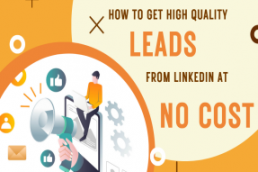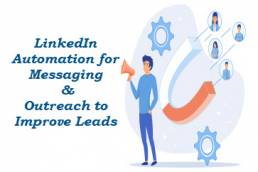Are you struggling to generate leads for your business? Are you tired of implementing the same old lead generation strategies with little success? It’s time to step up your game and take advantage of automated processes! Automated lead generation can help streamline your efforts, increase efficiency, and ultimately maximize your potential for generating quality leads. In this blog post, we’ll dive into what exactly is a lead, the different types of leads, various lead generation processes available to businesses today, and most importantly – how automation tools like LinkedIn Automation Tool can revolutionize the way you approach marketing. Don’t miss out on this opportunity to maximizing your lead generation potential with automated processes!
Understanding of Maximizing Your Lead Generation?
At the core of any successful business lies a steady flow of leads. But what is a lead, exactly? A lead can be defined as an individual or organization that has shown interest in your product or service and has provided their contact information for follow-up communication.
There are different types of leads, including marketing-qualified leads (MQLs) and sales-qualified leads (SQLs). MQLs are typically individuals who have expressed some level of interest in your offering, but may not be ready to make a purchase just yet. On the other hand, SQLs have demonstrated more serious intent to purchase and are further along in the buying process.
Leads can come from various sources such as social media, website visitors, trade shows/events, referrals, or purchased lists. Regardless of where they come from, it’s important to treat them with care, as they could potentially turn into paying customers.
Lead generation strategies aim to attract and gather information from potential buyers through various marketing campaigns which include content creation like blogs, while LinkedIn Automation Tools provide automated processes that help businesses scale these efforts efficiently.
Types of Leads
To effectively generate leads, it’s important to understand the different types of leads out there. The two main categories are marketing qualified leads (MQLs) and sales qualified leads (SQLs).
MQLs are potential customers who have shown interest in a company’s product or service but aren’t quite ready to make a purchase yet. They may have downloaded an eBook, signed up for a newsletter, or attended a webinar.
On the other hand, SQLs are those who have moved further down the sales funnel and are closer to making a purchase. These individuals have actively engaged with the company and expressed their readiness to buy.
It’s also worth mentioning that there’s another type of lead known as a product-qualified lead (PQL). This is someone who has used your product or service before and has shown interest in upgrading or purchasing additional products from you.
By understanding these different types of leads, businesses can tailor their lead generation strategies accordingly. For example, they might focus on nurturing MQLs through email campaigns while providing more personalized attention to SQLs through one-on-one conversations with sales reps.
Lead Generation Processes
Lead generation is a crucial process for any business, as it helps in finding potential customers who are interested in the products or services you offer. To effectively generate leads, businesses need to have a clear understanding of their target audience and their needs.
There are several ways to generate leads, such as through email marketing campaigns, social media advertising, content marketing, and search engine optimization (SEO). Businesses can also use lead magnets such as eBooks or webinars to attract potential customers.
Another important aspect of lead generation is the creation of landing pages that are designed specifically for converting visitors into leads. These pages should focus on highlighting the benefits of your product or service while addressing customer pain points.
Once leads have been generated, they need to be nurtured through targeted communication and personalized messaging. This involves understanding where each lead is in the buyer’s journey and tailoring your approach accordingly. Successful lead generation requires a strategic approach that encompasses multiple channels and tactics tailored toward your specific business goals.
Automated Lead Generation
Automated lead generation is a process that involves using software and tools to automatically identify, attract, and qualify leads. This process can significantly reduce manual work for marketers while increasing the speed and efficiency of generating quality leads.
The first step in implementing automated lead generation is identifying your target audience. You need to understand who they are, their pain points, interests, buying habits, and more. Once you have this information, you can use it to create personalized messages that resonate with them.
Next up is choosing the right automation marketing tool for your business needs. There are numerous options available, ranging from email marketing platforms to social media management tools that can help with lead generation through LinkedIn automation.
One of the best benefits of using automated processes for lead generation is its ability to scale effectively without losing quality or accuracy. You can set up workflows and drip campaigns that will nurture leads over time until they are ready to make a purchase decision.
In conclusion – Automated lead generation has become an essential part of modern-day digital marketing strategies, as it helps businesses save both time and money while improving their overall ROI by delivering better-qualified leads at a faster pace than traditional methods could ever achieve.
Benefits of Automated Lead Generation
Automated lead generation has become an essential tool for sales and marketing teams to increase their efficiency and productivity. One of the main benefits of automated lead generation is that it allows businesses to reach a wider audience by identifying potential customers who might be interested in their products or services.
Using automation tools, companies can gather customer data from various sources such as social media, email campaigns, website traffic, etc. This information helps them create targeted marketing campaigns that resonate with their target audience, increasing the chances of conversion.
Another advantage of automated lead generation is that it saves time and resources. Instead of manually sifting through heaps of data looking for leads, automated processes do this task quickly and accurately.
Moreover, automation minimizes human error by reducing manual intervention in crucial tasks like sending emails or following up on leads. It allows sales reps to concentrate on building relationships with prospects rather than wasting time performing repetitive administrative tasks.
Implementing an effective automation strategy increases overall revenue growth while decreasing costs associated with traditional methods. By leveraging LinkedIn Automation Tools and other automation software solutions out there in the market today – businesses can scale faster without worrying about additional overheads which come along when scaling using traditional means.
How to Implement Automated Lead Generation
When it comes to implementing automated lead generation processes, there are a few key steps you should follow. First, identify the areas of your current lead generation strategy that can be automated and streamlined. This might include email marketing campaigns or social media outreach.
Next, research and select the right automation tools for your business needs. There are many options available in the market today, so take the time to evaluate each one carefully before making a decision.
Once you have chosen your automation tool(s), set up workflows and templates for your various lead generation activities. These should include personalized email sequences, targeted landing pages, and social media posts.
Make sure to also integrate your automation software with other tools such as CRM platforms or analytics programs to ensure seamless tracking of leads throughout their journey.
Regularly monitor and analyze the performance of your automated processes through data-driven insights. Use this information to make adjustments and improvements over time for even greater success in generating high-quality leads on autopilot!
Case Studies
Perhaps the best way to understand the benefits of automated lead generation is through real-life examples. That’s why we’ll be taking a look at some case studies.
First up, let’s examine how a marketing agency was able to increase their lead volume by 400% using automation. By integrating an automation tool into their LinkedIn outreach process, they were able to automate connection requests and follow-up messages. This allowed them to focus on more important tasks while still generating high-quality leads.
Another example comes from a B2B company that used automated email campaigns to nurture leads and improve conversion rates. By sending targeted emails based on user behavior and interests, they were able to see significant improvements in engagement and ultimately increase their revenue.
Let’s take a look at how a software company utilized webinars as part of their automated lead generation strategy. By promoting webinars through social media ads and targeted landing pages, they were able to attract highly engaged prospects who were already interested in learning more about their product.
These case studies demonstrate just how effective automated processes can be when it comes to generating leads and improving conversions.
Conclusion
In today’s digital age, where competition is fierce and time is of the essence, automated lead generation has become a necessity for businesses to stay ahead. By using automation tools such as LinkedIn Automation Tool and Automation Marketing, companies can streamline their lead generation processes without compromising on quality.
By adopting an effective strategy for automating your lead generation process, you can focus on more strategic tasks while still achieving high-quality leads for your business. With proper planning and execution in place, you will be well-equipped to maximize your lead generation potential through automation.



